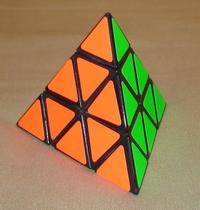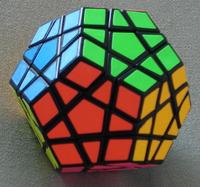
The Rubik's Revenge is a 4×4×4 version of Rubik's Cube. It was released in 1981. Invented by Péter Sebestény, the Rubik's Revenge was nearly called the Sebestény Cube until a somewhat last-minute decision changed the puzzle's name to attract fans of the original Rubik's Cube. Unlike the original puzzle, it has no fixed facets: the centre facets are free to move to different positions.

The Professor's Cube is a 3-D combination puzzle, a 5×5×5 version of the original Rubik's Cube. It has qualities in common with both the 3×3×3 Rubik's Cube and the 4×4×4 Rubik's Revenge. The ability to know to solve 3x3x3 Rubik's Cube will help, but it is recommended to know both Cubes to be able to solve the Professor's Cube.

The Pyraminx is a regular tetrahedron puzzle in the style of Rubik's Cube. It was made and patented by Uwe Mèffert after the original 3 layered Rubik's Cube by Ernő Rubik, and introduced by Tomy Toys of Japan in 1981.

The Square-1, also known as Back to Square One and Cube 21, is a puzzle similar to the Rubik's Cube. Its distinguishing feature among the numerous Rubik's Cube variants is that it can change shape as it is twisted, due to the way it is cut, thus adding an extra level of challenge and difficulty. The Super Square One and Square Two puzzles have also been introduced. The Super Square One has two additional layers that can be scrambled and solved independently of the rest of the puzzle, and the Square Two has extra cuts made to the top and bottom layer, making the edge and corner wedges the same size.

The Megaminx or Mégaminx is a dodecahedron-shaped puzzle similar to the Rubik's Cube. It has a total of 50 movable pieces to rearrange, compared to the 20 movable pieces of the Rubik's Cube.

The Dogic is an icosahedron-shaped puzzle like the Rubik's Cube. The 5 triangles meeting at its tips may be rotated, or 5 entire faces around the tip may be rotated. It has a total of 80 movable pieces to rearrange, compared to the 20 pieces in the Rubik's Cube.

The Skewb Diamond is an octahedron-shaped combination puzzle similar to the Rubik's Cube. It has 14 movable pieces which can be rearranged in a total of 138,240 possible combinations. This puzzle is the dual polyhedron of the Skewb. It was invented by Uwe Meffert, a German puzzle inventor and designer.

The Rubik's Cube group is a group that represents the structure of the Rubik's Cube mechanical puzzle. Each element of the set corresponds to a cube move, which is the effect of any sequence of rotations of the cube's faces. With this representation, not only can any cube move be represented, but also any position of the cube as well, by detailing the cube moves required to rotate the solved cube into that position. Indeed with the solved position as a starting point, there is a one-to-one correspondence between each of the legal positions of the Rubik's Cube and the elements of . The group operation is the composition of cube moves, corresponding to the result of performing one cube move after another.

The Pyramorphix, also called Pyramorphinx, is a tetrahedral puzzle similar to the Rubik's Cube. It has a total of 8 movable pieces to rearrange, compared to the 20 of the Rubik's Cube. Though it looks like a simpler version of the Pyraminx, it is an edge-turning puzzle with the mechanism identical to that of the Pocket Cube.

The V-Cube 6 is a 6×6×6 version of the original Rubik's Cube. The first mass-produced 6×6×6 was invented by Panagiotis Verdes and is produced by the Greek company Verdes Innovations SA. Other such puzzles have since been introduced by a number of Chinese companies, some of which have mechanisms which improve on the original. Unlike the original puzzle, it has no fixed facets: the center facets are free to move to different positions.

The V-Cube 7 is a combination puzzle in the form of a 7×7×7 cube. The first mass-produced 7×7×7 was invented by Panagiotis Verdes and is produced by the Greek company Verdes Innovations SA. Other such puzzles have since been introduced by a number of Chinese companies, some of which have mechanisms which improve on the original. Like the 5×5×5, the V-Cube 7 has both fixed and movable center facets.

The Pyraminx Crystal is a dodecahedral puzzle similar to the Rubik's Cube and the Megaminx. It is manufactured by Uwe Mèffert and has been sold in his puzzle shop since 2008.

The Helicopter Cube is a Rubik's Cube-like puzzle invented by Adam G. Cowan in 2005 and built in 2006. It is also in the shape of a cube. At first glance, the Helicopter Cube may seem like a combination of the 2x2x2 and the Skewb, but it actually cuts differently, and twists around cube edges rather than cube faces. The purpose of the puzzle is to scramble the colors, and then restore them back to their original state of a single color per face.

Alexander's Star is a puzzle similar to the Rubik's Cube, in the shape of a great dodecahedron.
The original Rubik's cube was a mechanical 3×3×3 cube puzzle invented in 1974 by the Hungarian sculptor and professor of architecture Ernő Rubik. Extensions of the Rubik's cube have been around for a long time and come in both hardware and software forms. The major extension have been the availability of cubes of larger size and the availability of the more complex cubes with marked centres. The properties of Rubik’s family cubes of any size together with some special attention to software cubes is the main focus of this article. Many properties are mathematical in nature and are functions of the cube size variable.

A Tuttminx is a Rubik's Cube-like twisty puzzle, in the shape of a truncated icosahedron. It was invented by Lee Tutt in 2005. It has a total of 150 movable pieces to rearrange, compared to 20 movable pieces of the Rubik’s Cube.

The Pyraminx Duo is a tetrahedral twisty puzzle in the style of the Rubik's Cube. It was suggested by Rob Stegmann, invented by Oskar van Deventer, and has now been mass-produced by Meffert's.

The Nine-Colour Cube is a cubic twisty puzzle. It was invented in 2005 by Milan Vodicka and mass-produced by Meffert's seven years later. Mechanically, the puzzle is identical to the Rubik's Cube; however, unlike the Rubik's Cube, which only has 6 different colours, the Nine-Colour Cube has 9 colours, with the individual pieces having one colour each.

The V-Cube 8 is an 8×8×8 version of the Rubik's Cube. Unlike the original puzzle, it has no fixed facets: the center facets are free to move to different positions. The design was covered by Panagiotis Verdes' patent from 2007 but Verdes Innovations SA did not produce it for sale until 2014. Other 8×8×8 cubes are produced by the Chinese companies QiYi, Cyclone Boys, ShengShou, MoYu, and YuXin.

The Dino Cube is a cubic twisty puzzle in the style of the Rubik's Cube. It was invented in 1985 by Robert Webb, however it was not mass-produced until ten years later. It has a total of 12 external movable pieces to rearrange, compared to 20 movable pieces on the Rubik's Cube.


























